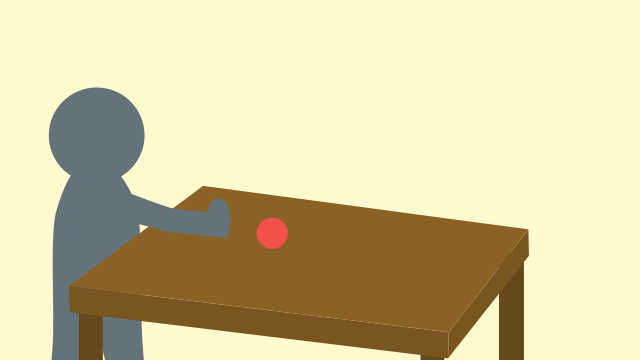This is more of me trying to understand how people imagine things, as I almost certainly have Aphantasia and didn’t realize until recently… If this is against community rules, please do let me know.
The original thought experiment was from the Aphantasia subreddit. Link: https://www.reddit.com/r/Aphantasia/comments/g1e6bl/ball_on_a_table_visualization_experiment_2/
Thought experiment begins below.
Try this: Visualise (picture, imagine, whatever you want to call it) a ball on a table. Now imagine someone walks up to the table, and gives the ball a push. What happens to the ball?
Once you're done with the above, click to review the test questions:
- What color was the ball?
- What gender was the person that pushed the ball?
- What did they look like?
- What size is the ball? Like a marble, or a baseball, or a basketball, or something else?
- What about the table, what shape was it? What is it made of?
And now the important question: Did you already know, or did you have to choose a color/gender/size, etc. after being asked these questions?
A vague thought of a ball and knowledge of what would happen. Nothing else.
Exactly. There’s no need to add more details unless that’s part of the requirements. Otherwise it makes it harder to keep track of things. Keep it simple first, then add complexity as needed.
Exactly. It rolls for a while unless it reaches an edge.
I love how by default most tables were wooden and the balls were mostly about baseball size
Apparently I’m in spooky brain mode cause mine was a crystal ball
- What happens to the ball? It rolls of the side of the table.
- Color: I didn’t imagine a specific color
- Gender: I didn’t imagine a specific gender. Most of the person was “out of the frame”
- What did they look like: Again, most of the person was out of the frame, they were just kind of a gray silhouette
- What size was the ball? Like a dodgeball I guess?
- What about the table? Very minimalist square table made up of five rectangular prisms (the surface and four legs). No specific material, uniform texture. I imagined everything in isometric perspective.
This is what I recall from my first time imagining the scenario, I’d have to imagine some more if I wanted to give specific answers.
With all due respect, I don’t believe aphantasia is a real thing. The way people imagine things is so varied, weird, strange, and unique that I don’t think it makes sense assigning labels. Different people will give varying levels of detail to different parts of their imagination based on their past experiences and knowledge.If you ask someone to imagine a chessboard, someone who plays chess might imagine a specific opening or valid board state, while someone who doesn’t might just have a vague blob of chess pieces on a board.
Even with your ball on a table experiment, the experiences people have had throughout the day may give more or less detail to the imagined scenario. I’m fairly certain that the reason I imagined everything so abstractly is because recently I found an artwork with a similar minimalist isometric style that I liked a lot, so it’s kind of floating around in my subconsciousness and affecting how I imagine things.
With all due respect, I don’t believe aphantasia is a real thing. The way people imagine things is so varied, weird, strange, and unique that I don’t think it makes sense assigning labels
Labels should always be used with caution, but for me, learning about aphantasia led to me reconsidering the ways in which I imagine things, and this had a beneficial impact on how I communicated with people close to me. For example, I seem to be an odd mixture of relying on visual stimuli for thinking (so I have visual reminders all over, and reading complex info is way easier for me than hearing it), but also seem to lack the ability to visualise. This means that if my partner asks “hey, do you remember which drawer the mini screwdrivers are in?”, I would usually be unable to answer, despite being able to walk in, take a glance at the drawers and go “that one, there”. We didn’t realise how frustrating this was for both of us until we reflected on the possibility of me having aphantasia. Whether I do or not doesn’t matter. More relevant is the fact that now, when he asks me questions of where things are, it’ll often be accompanied by a photograph of the location, which drastically improves my ability to recall and point to where the item is.
To some degree, I agree that it’s nonsense to assign labels when in nature and in humans, variation is the norm. Certainly it can lead to reductionism and ignoring wide swathes of that variety if one is on a quest to sort people into boxes. However, there is still a lot that we don’t know about how the brain works to process things and labels can be instructive either in researching aspects that we don’t yet understand, or for regular people like me who find benefit in a word that helps me to understand and articulate that there are ways that my partner thinks and processes information that seem to be impossible for me to emulate. “Aphantasia” helped both of us to be more accepting of these differences.
Framing a phenomenon as either real or not isn’t especially useful though, largely because of the ambiguity in the phrasing. An example in a different domain is that I’ve seen a wide variety of people claim that they don’t think autism is a real thing. This tends to be received as offensive to many people, not least of all autistic people who feel like their lived experience is being directly attacked and questioned. Sometimes it is, and their anger is justified. However, I’ve also seen the “autism isn’t a real thing” sentiment come from (often autistic) people critiquing the label and how it’s used, especially in a clinical context. They argue that it perpetuates a binary framing of autistic and not autistic, which further marginalises people who do have a diagnosis, and isolates some people who have autistic traits but are overall sub-clinical in presentation (who may have benefitted from understanding these traits from an autistic perspective). Regardless of one’s view of the arguments, it’s pretty clear that these are two very different stances that might be described by “autism isn’t a real thing”.
I make this example because debating of the utility of labels can be a great and fruitful discussion that helps to improve our understanding of the underlying phenomena and people’s experiences of them. Framing that debate as what’s real or not can lead to less productive arguments that are liable to cause offence (especially on the internet, where we’re primed to see things in a more adversarial manner)
With all due respect, I don’t believe aphantasia is a real thing.
It does, it’s a studied and proven condition. No idea why you wouldn’t believe it lol
I imagined it in a cartoon-ish fashion, so I think I can actually draw it out.

- Red ball
- Male
- Like Google’s default profile picture, without facial features, except he’s in gray and has a neck
- My single hand can surround more than half of it in a cross section view, so about 12cm in diameter
- Rectangular table, about 5:2, I didn’t imagine the material, but it’s plain brown, so I guess wood?
Additionally, the ball rolls parallel to the long edge of the table, and falls off the short edge. The person also have legs.
I already had these in my mind before being asked.
My brother in Christ you have described almost the exact same specs I visualized. The only difference is in the level of resolution of my “scene.” And by that, I mean essentially I did a few more render passes in my head to anchor everything you’ve written within a sort of Impressionistic, highly softened, out-of-focus backdrop. I saw hints of shadowy cabinets, the concept of a darkened kitchen out of sight. The shape and finger placement of my slightly more textured, clothed yet featureless male. The gray-brown feeling of a floor below, a dark white ceiling above, and the faded glow of sunlight through an unseen dining room window grazing one end of that oaken table.
But the basics … They’re the same, and before being asked to recall them. Damn.
I mean, people will imagine a similar thing when asked to imagine something specific. At the end of the day there’s just so many ways to imagine someone pushing a ball off a table.
More or less but person didn’t have gender because that wasn’t relevant to the subject which was the rolling ball. Ball also bounced a few times when hitting the floor.
Colorless ball, around the size of a tennis ball on a colorless round table. Person was colorless, genderless, and generally without any distinctive features.

What is my diagnosis?
Yep pretty much what I got
Since we all went with colorless, I imagine that means we weren’t doing visual stuff at all. It’s all bones.
I’ve noticed that after getting older, suffering several concussions, a short spat with drinking, and COVID that my ability to picture things in my mind has degraded a lot since childhood.
Does your ability to imagine things naturally decline? I remember as a lad I could vividly imagine the feeling of things. My imagination was also much more colorful. But I could never see things in 3D like some people can (I’ve worked with some really talented tradesmen/machinists who can like assemble or fold or machine a piece in their mind, I don’t know maybe that’s just practice)
Mine got better as I got older. Especially after some experiments with psychedelics. I didn’t think I was able to imagine a 3D object in detail, and for most of my life I wasn’t. But then I had a shroom trip in which I was able to freely rotate an imagined 3D object. Even render an object in my mind based solely on touch.
Afterwards I went back almost to normal, but not completely. It’s like I learned to use some previously inactive part of the brain.
Wait a second.
- The ball had no color at all
- The person who pushed the ball didn’t even exist. It just got pushed by some invisible force. Naturally, they didn’t have an appearance.
- The ball was like… Small I guess?
- The table had no properties at all.
Do people really usually have a more vivid picture in their heads? It’s always just concepts with me. I’m confused.
I also had the “I spent 23 minutes designing this scene in blender” impression of the ball, table, and disembodied hand. The table was made of light grey, the ball was made of light grey, and the hand was made of light grey
Yeah, same with me. But I knew the ball was pushed and rolled to the edge of the table and then fell, so I feel like I got the most relevant bit.
Tbh I’ve never been good at visualising faces, recognising people I know, retracing a route I’ve taken etc. This just feels like one of those things I’ve never really been great at.
Do people really usually have a more vivid picture in their heads?
I can’t speak for others, but I do if they’re concepts I’ve encountered before. I have “default” visualizations of things that are changed if the description warrants it.
The ball rolls for a bit then stops
- Colorless ball
- Didn’t image a gender, just the concept of a person
- They didn’t look like anything
- I guess a perfect colorless sphere roughly the size of a tennis ball
- Pretty much just a rectangular flat surface. There’s no color or material
I didn’t know much about it except the size of the ball being roughly proportional to the size of a human hand
I have complete aphantasia, I can’t even visualize a ball or table, or anything else - never have been able to, I see absolutely nothing when I close my eyes and can’t visualize or see things in my head at all except when dresming. Same for my Dad. He can apparently visualize an extremely tiny amount (like the night sky but just black + stars, etc) when he’s high on thc gummies. I’ve never been high so idk if it works for me.
It took me 24 years to realize that people actually can actually see images in their head when they think about something or intentionally imagine it. I always thought that phrases like “picture it in your head” or “see in your head what it will look like” were just phrases, not that people actually can see things when they think about it.
Hmm have you been on LSD? I’m curious if your experience with it is different from someone who doesn’t have aphantasia?
Nope, haven’t done anything harder than ibuprofen tbh, never had a desire to try. I do dream visually though
Answer:
It was a simplistic grescale scenario devoid of unnecessary features. Think a simple and fast 3D render from the 90s or something. So everything was grescale, the person had no gender (or even features), and pushed a baseball sized sphere on a simple rectangular table made of indeterminate materials. Now I can picture something more detailed if required or desired but my mind focused on the mechanics of it all and kept details to a minimum. Asking for these details afterwards doesn’t generate them retroactively.
The ball was red, like a red rubber ball. The person was sort of indistinct from the neck up, it was more like my view was focused on the ball itself and didn’t see a face, but it was a man, wearing a white shirt and dark tie, and dark pants. The ball was about the size of a baseball, wasn’t completely smooth and shiny, sort of a matte with a slight grippy texture. Table was square, wood, like a medium brown color. The ball rolled off the table and bounced a few times.
All these decisions were automatic when reading the prompt, it’s what I saw.
I’ve just become aware of aphantasia myself, I have a few family members who have it apparently. I was talking to my BIL about it the other day, I was saying how I’m a big fan of reading, but I mostly read nonfiction. He said he doesn’t read much, mostly biographies, but fiction doesn’t do much for him because he can’t picture anything in his head. I can picture everything in great detail when I read fiction. Its interesting because our minds work very differently
I imagined the same red, baseball-ish sized rubber ball. Not sure why that’s my default for “ball.”
+1 for a red rubberlike ball … looks like a pattern emerges
Neat!
spoiler
- Red. It was rubber.
- Male.
- Tall, thin. I don’t remember a face, but he was wearing an old-fashioned formal shirt and sport jacket. The cuff of the shirt was unbuttoned and folded back. He also wore a wide-brimmed black hat. (I’m currently watching an episode of Hell on Wheels which probably influenced that.)
- Large for an apple, small for a canteloupe.
- Square, dinner-table-hieight. Dark-stained wood. I’m no woodworker, so I wouldn’t know what kind of wood it was, but I’ve got a couple of bookcases of the same wood and staining.
Aside from that, I can say it took place in an old cabin and in the background, I saw an open doorway to a… foyer? The door to the outside was open. It was very sunny. And I saw green grass outside.
And, I knew all those things before I got to the questions. I just had to consult/replay the scene in my head to get all the answers.
Seems fair to say I don’t have aphantasia.
- The ball was red.
- I have no idea.
- I have no idea.
- Like, maybe softball sized? A little bigger? I’m not sure.
- Square. It was made of brown.
I’ve put some effort into improving my visualization since learning about aphantasia. Upon reading the prompt, I was able to imagine a colorless ball, but with shading to indicate a 3D shape, like a preview render in a CAD program. That’s progress! It didn’t have a size inherently. For the table, I could picture a white, rectangular plane hovering in a black void. If it was a normal dinner table size, then the ball was something like a softball or basketball.
And that’s it. That exhausted my ability to visualize. No person, no push, no motion. Best I can do is to see the white rectangle after the ball has rolled off of the edge.
I find it very interesting that the vast majority of people saw a red ball. I did too.
::: spoiler
- red
- Indeterminate, mostly just an arm
- shoulder-length brown hair, androgenous body, hidden face
- Like a rubber bouncy ball you’d get in a party bag
- wooden, square
Mostly I already knew, but it felt like things were “filling in” as I tried to “remember” the image to answer the questions, especially around the person.
:::
I imagine it’s because it’s the simplest, most common type of ball that you commonly see described as such. Like, baseballs and basketballs and soccer balls and beach balls exist, but out of context they’re typically called that rather than just “a ball”. So, a simple round ball. Giving it a pattern requires some extra thought, and of the solid colors red seems like the most common (think dodgeballs).
Same






